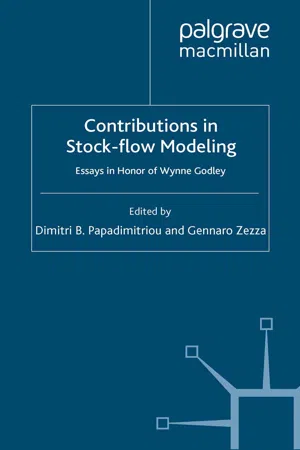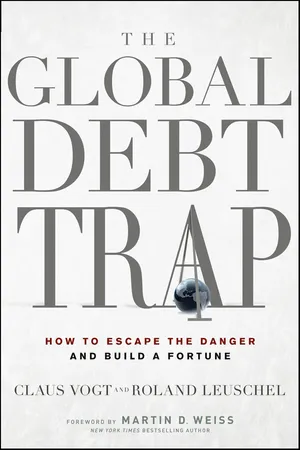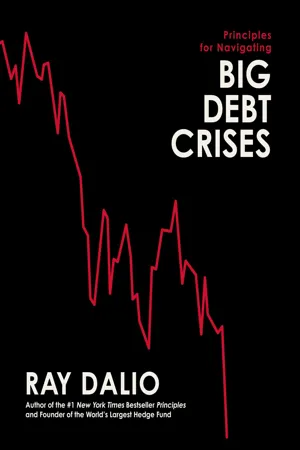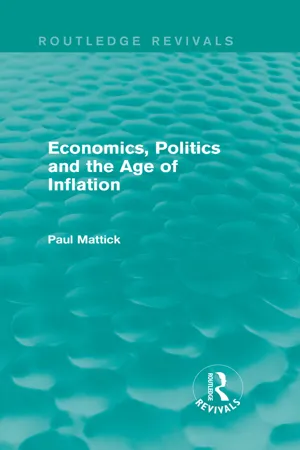Economics
Debt Deflation
Debt deflation refers to a situation where the overall level of prices in the economy falls, leading to an increase in the real burden of outstanding debt. This can result in a downward spiral as falling prices lead to lower incomes and asset values, making it harder for debtors to repay their debts, which in turn can further depress economic activity.
Written by Perlego with AI-assistance
Related key terms
1 of 5
9 Key excerpts on "Debt Deflation"
- eBook - PDF
Contributions to Stock-Flow Modeling
Essays in Honor of Wynne Godley
- D. Papadimitriou, G. Zezza, D. Papadimitriou, G. Zezza(Authors)
- 2011(Publication Date)
- Palgrave Macmillan(Publisher)
The economy contracts as a result of the de-leveraging activities of firms and households, which further deepens the crisis. Combined with increases in government expenditure from automatic stabilizing mecha- nisms like social welfare payments, the increase in debt-servicing costs 235 D.B. Papadimitriou et al. (eds.), Contributions in Stock-flow Modeling © Palgrave Macmillan, a division of Macmillan Publishers Limited 2012 236 Contributions in Stock-flow Modeling can be punitive for small open economies like Ireland, unable to stimulate their economies in a textbook Keynesian (or new-Keynesian) manner. Tobin (1980, p. 58) describes the debt-deflation problem in stark terms: When nominal prices and wages are deflated, debt service is a higher proportion of debtors’ incomes, and the reduction or elimination of their margins of equity disqualifies them from further access to credit. Bankruptcies and defaults do likewise, and transmit the distress of debtors to their creditors, threatening the solvency and liquidity of individual lenders and financial institutions. The issue of stability arises because the relation runs both ways: defla- tion causes financial distress, and financial distress in turn exacerbates deflation. Negative aggregate price shocks had a significantly negative impact on financial conditions during the Great Depression. On the debit side of the balance sheet, deflation decreases the pur- chasing power of the debtor at a time when the economy requires increased levels of consumption and investment, which deepens the downturn, and exacerbates the crisis. The two depressions of the past 150 years – the 1890s and the 1930s – had substantial deflations. Prices fell at up to 15 per cent per annum in the 1890s in the United States. Prices fell over 10 per cent per annum for two years during the Great Depression (DeLong, 1999). - eBook - ePub
Fear and Greed
Investment risks and opportunities in a turbulent world
- Nicolas Sarkis(Author)
- 2012(Publication Date)
- Harriman House(Publisher)
These various choices are not mutually exclusive. As an economy grows naturally, some inflation usually occurs too, thus shrinking the debt in two ways simultaneously. There will also likely be some shrinkage of the debt from defaults and restructurings even if growth and inflation are in evidence. However, deleveraging periods are usually dominated by one of these three forces in particular.The optimal outcome is if the economy experiences genuine growth in order to ease its debt-burden. This can be a tall order in cases where debt is especially heavy, as the research of Reinhart and Rogoff has so ably demonstrated. In cases of heavy indebtedness, the natural tendency is often towards a deflationary collapse. The classic example of this was the Great Depression of the 1930s.Shortly after the 1929 to 1932 meltdown, Irving Fisher explained a deflationary debt-collapse in terms of a chain of consequences. First, investors seek to pay off debt en masse , resulting in distress-selling. In turn, this leads to shrinking bank credit and a falling stock of money. Prices then fall, squeezing profits and the value of assets. Trade contracts and businesses lay off workers, leading to lower confidence all round and money-hoarding. As prices fall, interest costs effectively rise.The science of economics has become more sophisticated since Fisher’s time, but his basic message still resonates. “It is always economically possible to stop or prevent such a depression simply by reflating the price level up to the average level at which outstanding debts were contracted by existing debtors and assumed by existing creditors, and then maintaining that level unchanged,” he wrote.[21]This logic has inspired the money-printing or quantitative easing exercises that central banks in the West have pursued in response to the latest crisis.Deleveraging through inflation
Although quantitative easing is not a new idea, the scale of these efforts over recent years has been unprecedented. Between 2008 and 2011, America’s Federal Reserve created more than $2 trillion out of thin air, which it has used in order to buy up US government bonds and other assets, and thereby pump money into the financial system. The Bank of England (BoE) was even more zealous in its approach, such that it owned an astonishing one-third of the total UK government bonds in issue as of early 2012. - eBook - ePub
The Coming Bond Market Collapse
How to Survive the Demise of the U.S. Debt Market
- Michael G. Pento(Author)
- 2013(Publication Date)
- Wiley(Publisher)
stable means not easily moved. However, to the men and women who control our money supply, it means increasing about 2 percent a year. So determined are they that the economy not be met by the evil deflationary monster that they create inflation of 2 percent (as measured by the phoniest of inflation measurements known as the Personal Consumption Expenditure Price Index). This is done as a buffer or wall to block evil deflation from coming in—because once that evil deflation monster enters the economy, they fear he will never leave.The word deflation is a little nebulous in that it is used by economists in a technical way to describe a decline in the money supply. Most laypeople view deflation as a generalized decline in prices. Inflation , in turn, would refer to an increase in prices or, more technically speaking, an increase in the money supply or the fear of such a future increase in its supply that causes a decline in the purchasing power of the currency.As a follow-up to my introduction on decreasing prices, I have decided to start my critique of Fed myths with the Keynesian Fed-lore of the “deflationary death spiral”; this Fed-lore is very widely held and promulgated. The men and women at the Federal Reserve believe that a slight increase in prices is a sign of a growing economy and falling prices are devastating.Let’s put this Keynesian Fed-lore to the test and see how it holds up.In an economic environment of increasing productivity accompanied by a static money supply, one would assume that prices would slightly decrease. As an industry becomes more productive and makes better use of technology, those technological advances aid in the reduction of costs associated with producing the product. Profit margins improve, and in a competitive environment, businesses will pass most of these savings on to consumers. So with truly stable prices, the costs of many items would go down, and that would be a positive result; it would indicate that businesses were leveraging productivity to increase profit margins and decreasing the price of goods to consumers. However, outside of technology, we rarely see this materialize.Those at the Fed view any deflation as harmful, regardless of the cause. Ben Bernanke has said that “deflation is in almost all cases a side effect of a collapse in aggregate demand—a drop in spending so severe that producers must cut prices on an ongoing basis in order to find buyers.”1 - eBook - ePub
The Global Debt Trap
How to Escape the Danger and Build a Fortune
- Claus Vogt, Roland Leuschel, Martin D. Weiss(Authors)
- 2010(Publication Date)
- Wiley(Publisher)
CHAPTER 4 The Road to (Hyper)InflationWill the bursting of the real estate bubble lead to a deflationary endgame? Or will the printers of money with their so-called rescue packages and unaffordable economic stimulus programs prevail, producing rampant inflation? That is the decisive question for investment success over the coming years. So it behooves you to become familiar with the arguments behind both scenarios, and this, in turn, is not possible without clearly defining the terms.Today, the terms inflation and deflation are generally used to refer to a rise or decline in price levels measured by a basket of consumer goods. Although technically accurate, the problem with this definition should be clear: it describes only one of many symptoms—namely price changes in a basket of goods that can be manipulated at will. However, the underlying cause of these price changes remains—intentionally—unclear. Plus, the composition of the consumer basket, along with the methods for measuring their price changes, leave an extremely broad latitude for generating politically desired results.In contrast, the classic definition of the terms inflation and deflation, which has now largely fallen into disuse, begins not with the symptoms but with the cause. Inflation (deflation) is an increase (decrease) in the supply of money and credit .Let’s first explore the latter. The Deflationary ScenarioThe direct consequence of speculative bubbles that burst is, of course, none other than a price collapse in the object of that speculation. If these are contained in the consumer basket, and if they cheapen the basket overall, then economists who base their definition on consumer prices will speak of deflation.Bursting speculative bubbles also are deflationary in classical definition: they lead to an increase in the demand for cash and a decrease in the supply of money and credit. Cash and equivalent—including cash in circulation, federal funds, money market funds, and other short-term instruments—are viewed as havens in times of great uncertainty in the financial markets, and they are thus in greater demand. - eBook - ePub
- Ray Dalio(Author)
- 2022(Publication Date)
- Avid Reader Press / Simon & Schuster(Publisher)
Inflationary depressions classically occur in countries that are reliant on foreign capital flows and so have built up a significant amount of debt denominated in foreign currency that can’t be monetized (i.e., bought by money printed by the central bank). When those foreign capital flows slow, credit creation turns into credit contraction. In an inflationary deleveraging, capital withdrawal dries up lending and liquidity at the same time that currency declines produce inflation. Inflationary depressions in which a lot of debt is denominated in foreign currency are especially difficult to manage because policy makers’ abilities to spread out the pain are more limited. We will begin with deflationary depressions.Passage contains an image
The Phases of the Classic Deflationary Debt Cycle
The chart below illustrates the seven stages of an archetypal long-term debt cycle, by tracking the total debt of the economy as a percentage of the total income of the economy (GDP) and the total amount of debt service payments relative to GDP over a period of 12 years.Throughout this section, I’ll include similar “archetype” charts that are built by averaging the deflationary deleveraging cases.31) The Early Part of the Cycle
In the early part of the cycle, debt is not growing faster than incomes, even though debt growth is strong. That is because debt growth is being used to finance activities that produce fast income growth. For instance, borrowed money may go toward expanding a business and making it more productive, supporting growth in revenues. Debt burdens are low and balance sheets are healthy, so there is plenty of room for the private sector, government, and banks to lever up. Debt growth, economic growth, and inflation are neither too hot nor too cold. This is what is called the “Goldilocks” period.2) The Bubble
In the first stage of the bubble, debts rise faster than incomes, and they produce accelerating strong asset returns and growth. This process is generally self-reinforcing because rising incomes, net-worths, and asset values raise borrowers’ capacities to borrow. This happens because lenders determine how much they can lend on the basis of the borrowers’ 1) projected income/cash flows to service the debt, 2) net worth/collateral (which rises as asset prices rise), and 3) their own capacities to lend. All of these rise together. Though this set of conditions is not sustainable because the debt growth rates are increasing faster than the incomes that will be required to service them, borrowers feel rich, so they spend more than they earn and buy assets at high prices with leverage. Here’s one example of how that happens: - Hans Neisser(Author)
- 2016(Publication Date)
C H A P T E R V I G E N E R A L D E P R E S S I O N A . T H E PROCESS OF D E F L A T I O N THE main vehicle for the progress of absolute deflation is the hoarding of current income. The decline in demand for current net output would reduce profits and eventually would create losses, even if certain cost elements were not fixed rigidly by contracts; for even then the adjustment of cost prices would necessarily lag behind the variations of the commodity price level, since it is caused by these varia-tions; and though the losses incurred would lower only the money value of the enterprises' capital, not its real value, entrepreneurs who anticipated a further fall in prices might reach for a deflationary gain in real capital by liquidating in time and keeping the capital in the form of money until the bottom of the slump seemed to have been reached. Thus, liquidation of capital represents a second means of deflation. When the entrepreneur is faced with a shrinkage in ultimate demand, either of the consumer or of the investor, he may react in one of three ways: either keeping up his output at the level indicated by the amount of his receipts and the actual costs per unit (which would not prevent him from hoarding net income) or raising the output above or lowering it below this level. 1 Only in the last case would he liquidate capital either to hoard it or to repay debts. 2 In the second case, he would reduce, pro tanto , net deflation. The actual attitude of the entrepreneur largely depends on his position in the process of economic circulation. Specu-1 The last-mentioned attitude is used as a basis of the general theory of dynamic disequilibrium by W. Lederer in Social Research, Nov. 1934 and Feb. 1935; cf. too, my reply in the latter issue. 1 The necessity of paying debts may bring about liquidation also when the an-ticipation of a future price fall is absent. 102- eBook - ePub
- Paul Mattick(Author)
- 2017(Publication Date)
- Taylor & Francis(Publisher)
2 Deflationary InflationIt is popular nowadays to distinguish between the inflation of time past and a new kind of inflation, which accordingly requires a new explanation, although in its monetary aspects inflation has the same features now as before: rising prices or the diminishing buying power of money. While its opposite, deflation, was viewed as contracted demand resulting in falling prices, inflation was explained by insufficient supply, driving prices up. Since, however, in this view it is the commodity market that determines price formation, little attention was paid to monetary policy. Money was seen merely as a veil concealing real processes, obfuscating them but altering little in their essential nature.This theory was also accompanied by the illusion, still lingering today, that the quantity of money in circulation in the economy has an important influence on commodity prices and that price stability depends on an equilibrium between the quantity of money and the total volume of goods. The modern advocates of the quantity theory of money also attribute deflation and inflation to a too slow or too rapid growth in the supply of money, and as a remedy to these anomalies they propose the creation of money adjusted proportionally to actual economic growth.Thus in money theory the economic cycle is represented as an expansion and contraction of the money supply and of credit not commensurate with the real situation. But it was expected that the equilibrium mechanism of the market would ultimately steer things back to normal. The crisis of the thirties, however, which seemed to have taken hold for good, put an end once and for all to any notions of such an automatic self-establishing equilibrium. In Keynes's view, which dominated bourgeois economic theory in the years that followed, the laws of the market were no longer capable of bringing about economic equilibrium with full employment. A developed capitalist economy, claimed Keynes, made for a decline in effective demand and with it a fall-off in investments and growing unemployment. Although this theory was designed specifically to explain economic stagnation during the period between the two world wars, it was quickly given universal status and regarded as the last word in the science of economics; to avoid the deflationary state of the depression and to restore economic equilibrium with full employment, state measures were needed to stimulate overall demand. - eBook - ePub
- Robert W. Dimand(Author)
- 2019(Publication Date)
- Palgrave Macmillan(Publisher)
Fisher, in contrast, emphasized the effect of the real value of nominal debt of changes in the price level that had not been anticipated when the debt was contracted. The possibility of bankruptcy created an asymmetry between the effect of falling prices and of rising prices. The bankruptcies and, even more, the fear of bankruptcy and loan default induced by falling prices and excessive nominal debts would increase risk premia on loans, lead to withdrawal of uninsured deposits from banks with loan portfolios considered in danger of default, and cause liquidation of assets and repayment of loans, all of which would depress asset prices and contract the money supply. The attempt to restore liquidity by selling assets to repay loans and increase bank reserves would be self-defeating, warned Fisher (1933, p. 346): “By March, 1933, liquidation had reduced the debts about 20 per cent, but had increased the dollar about 75 per cent, so that the real debt, that is debt measured in terms of commodities, was increased about 40 per cent.” Fisher (1933, p. 342) summarized the process expounded in Chapters II and III of Booms and Depressions in nine links. First, debt liquidation, resulting from some random shock such as the bursting of a bubble in stock prices, “leads to distress selling and to (2) Contraction of deposit currency, as bank loans are paid off, and to a slowing down of velocity of circulation”, so that (3) the price level drops, causing “(4) A still greater fall in the net worths of business, precipitating bankruptcies.” Profits are reduced (5), so that firms curtail production and employment (6) - eBook - ePub
Microfoundations and Macroeconomics
An Austrian Perspective
- Steven Horwitz(Author)
- 2000(Publication Date)
- Taylor & Francis(Publisher)
less than its specie holdings. Presumably any depositor of specie will want a receipt for that amount and that receipt serves as money. In addition, a bank that acquired specie on its own and then decided not to monetize it by lending it out would be sacrificing the interest earnings necessary to compensate for the cost of obtaining the specie. By ruling out absolute losses in specie from the definition of deflation, Rothbard can only see deflation as occurring after an inflation.In much of his discussion of the effects of inflation, Rothbard covers the standard Austrian ground of relative price effects, debtor-creditor redistributions, and the business cycle. He also recognizes that inflation is fundamentally a redistributive process. So much so that he is led to say that there is ‘no social utility in an increased supply, nor any social disutility in a decreased supply, of money. This is true for the transition period [between monetary equilibria] as well’ (1962:711).20 This is worded very carefully to leave open the possibility that inflation causes a decrease in utility and deflation an increase therein, but his emphasis is surely on the redistributive processes at work in both inflation and deflation. The nuances of that quote aside, in analyzing the effects of inflation, he is largely on target. What is interesting, but not surprising, is the dearth of attention paid to deflation. In the 30-page section where he discusses the effects of inflation (as an instance of ‘the economics of violent intervention in the market’), his discussion of deflation is less than two full pages. It occurs in the sub-section on ‘Secondary Developments of the Business Cycle’ and is mostly laudatory concerning the ways in which deflation is necessary to undo the effects of the necessarily prior inflation. Even the redistributive aspect of deflation is praised because it ‘takes away from the original coerced gainers [from inflation] and benefits the original coerced losers’ (1962:865). In addition, deflation can, by definition, never go farther than bringing the money supply down to equal the supply of specie, thereby doing the desirable deed of eradicating the inflation.21
Index pages curate the most relevant extracts from our library of academic textbooks. They’ve been created using an in-house natural language model (NLM), each adding context and meaning to key research topics.








